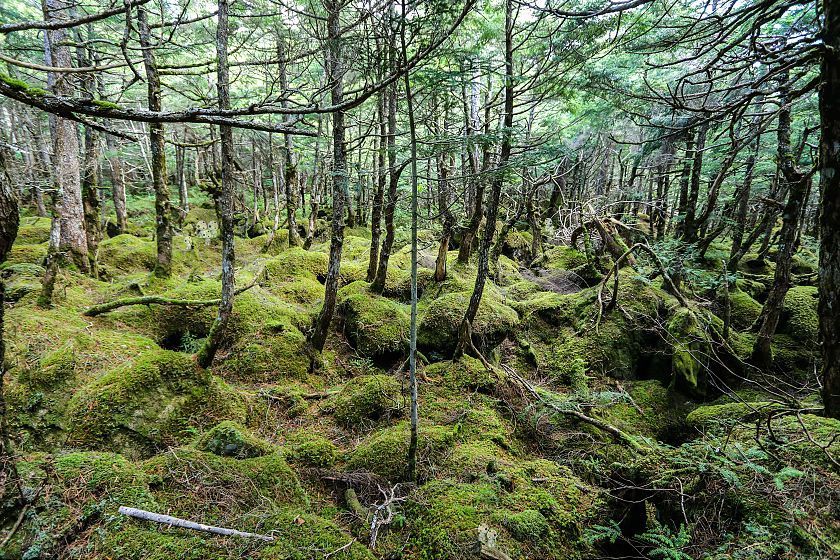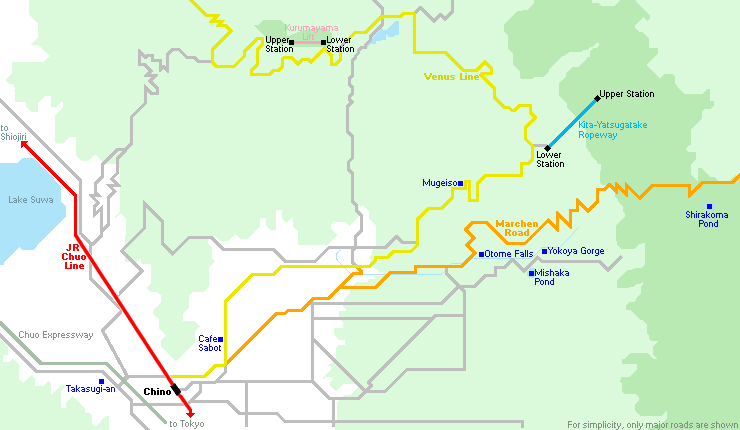Chasing the high life in Chino, Nagano

Nagano Prefecture is one of the few landlocked prefectures in Japan whose borders touch neither sea nor ocean. The lack of large bodies of water is made up for by plenty of mountains that provide a playground among the peaks for intrepid hikers. For this pre-summer edition of Chotto Zeitaku, I went on a cheat's version of "scaling" the peaks and combined that with visiting some of the quirky nooks in Chino (茅野), a city in eastern Nagano. The first part of my day was spent up in the highlands, before chasing some greenery and waterfalls for my second movement, and finally into the main part of town for my third and last act.

This trip to Chino can be done as a day trip or a leisurely overnight trip with a stay at an onsen ryokan near the mountains. The direct JR limited express trains Azusa and Super Azusa connect Shinjuku Station in Tokyo to Chino Station in about two hours. Getting around Chino is best by rental car as public buses are not as frequent and may limit the number of sights you can visit due to time constraints. Rental car companies can be found around Chino Station.
One of the main draws for driving in and around Chino is the presence of panoramic main roads, in particular the Venus Line and the Marchen Road-two winding roads that lead up the mountains - roads I drove on most of the day. I saw many nice cars and motorcycles (as well as a handful of cyclists) making their way up and down the roads when I was there. Needless to say, I enjoyed my Sunday drive which had me navigating the curving roads and visiting the tourist spots along the way.





Chino is not very well known and still low on the international tourist radar, perfect for those looking to escape the crowded major cities. Another plus point about visiting in the summer is the cooler temperatures that tend not to go over 30 degrees Celsius due to the higher elevation.
I started my day early at the Kurumayama Kogen Sky Park to take the chairlift up to the top to catch the sunrise. At 1925 meters, Kurumayama offers hiking in the green season and snow activities in winter, and hiking trails connect the mountain to other nearby peaks and highlands. Every Sunday from May through to early November, the lift opens just before sunrise and gives early birds a chance to see a sea of clouds (unkai) and/or the sunrise from above the town. Unfortunately for me, the weather was just too good and I was presented with an amazing sunrise against a cloudless blue sky. "Scaled" a mountain in just 15 minutes using the chairlift, checked.





From there I got on the Venus Line and drove up Marchen Road to get to my next two destinations. First up was Shirakoma Pond located in the mountains at 2115 meters above sea level. The trees around the pond showcase brillant autumn colors in the fall, but in this green season, the star for me was definitely the moss forest that surrounds the pond. The 40 minute walk around the pond plunged me into a different world and the sounds and feel of civilisation felt extremely far and foreign. Visited a moss forest, checked.






Raring to "scale" my next mountain, I went back down Marchen Road and made for the Kita-Yatsugatake Ropeway. This time, the ropeway brought me to an elevation of 2240 meters in about seven minutes. A number of hiking trails start from the upper ropeway station, including the short one 30-minute trail I took which afforded views of the nearby mountain ranges and volcanic terrain. Going to two mountain tops in a day, checked.




After the high of the first part of my day, it was time to take things down a notch. I went back down the Venus Line to a traditional farmhouse (kominka) called Mugeiso. This unassuming abode is the replica home of the acclaimed director Ozu Yasujiro - whose most well known work is Tokyo Story (Tokyo Monogatari) - and the original still remains at its original location not far away. The kominka showcases the works of Ozu and gives a glimpse of how he used to live, and also gives visitors a chance to see the inside of a traditional farmhouse.



Chasing waterfalls was next on my list and it was off to the Yokoya Gorge. There are a number of walking trails along the gorge that offer visitors a variety of options ranging from a quick 20-minute walk or a full three hour walk to see all the waterfalls along the way. Like at Shirokoma Pond, the gorge is also a popular spot to see autumn colors in season but I did not mind being surrounded by all the fresh greenery.



For my final act, I headed down into the city to wrap up my trip. My first stop in the city was the amazing Cafe Sabot that has mouthwatering international cuisine made with local ingredients. My order was cooked on the spot and tasted as good as it looked, which made me just want to try more of their menu.




To wrap up my trip, I headed across the train tracks to the western side of Chino Station. One of the major sightseeing attractions on this side of the station is Suwa Taisha, one of the oldest shrines in Japan and the head shrine for all the Suwa shrines in the country. However, I went past the shrine and headed not far away instead to check out some installation art teahouses. The quirky teahouses are surrounded by vegetable gardens and have mountains for a backdrop, and one of them even has the distinction of making the list as one of the "top ten dangerous buildings" in the world. Note that none of the teahouses can be entered unfortunately and visitors can only view them from the outside.


Despite the long day out, I felt like I had covered as much as my eyes could take in without being overwhelmed. Scaling the two peaks with the help of the chairlift and ropeway helped to save a lot of time while also allowing me to get views from the top. One of the highlights of my day was the short walk in the moss forest that surrounds Shirokoma Pond which I really enjoyed together with the stillness that enveloped the place. That said, one of the things I wished I had time for when I was in Chino was to try their hot spring waters. Guess I'll just have to save that for an overnight trip the next time.









